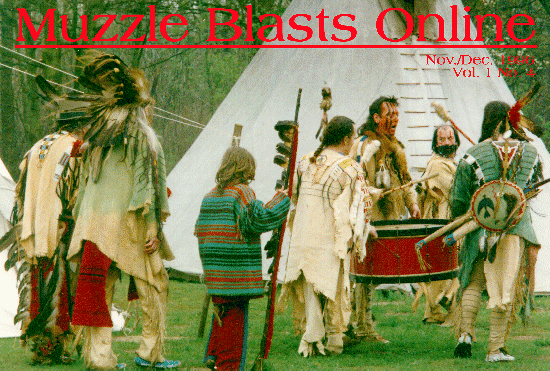|
Muzzle Blasts Online |
|
...for the muzzleloading enthusiast |
|
The muzzleblasts.com domain, subdomains, content, etc., are neither affiliated with the NMLRA nor its paper magazine Muzzle Blasts |
|
Muzzle Blasts Online |

|
|
|
|
|
|
Book Review
by James A. Crutchfield
Plano, TX
Republic of Texas Press
1506 Capital Avenue, 75074
[214] 881-9147 1995 Paperbound. 201 Pp. ISBN Number 1-55622-385-4. $12.95.
Crutchfield identifies tragedy as the events leading up to the assassination of the appointed Governor, Charles Bent, of the territory of New Mexico, and charges of murder and treason of those responsible for a failed revolt and the rapid deaths of those found guilty in a process that could only be termed as swift, frontier justice. The period of time covered in the actual scene of events was less than one year between 1846-1847. The entire scenario would probably occupy only a few pages in a general history text. But the tragedy underscored cultural antagonisms which deserves more space to be properly understood.
The strength of Tragedy at Taos: The Revolt of 1847, is that Crutchfield carries his readers through the underlying causes for the events leading up to the War with Mexico, the failure of volunteer forces under Stephen Watts Kearney (along with Colonel Alexander Doniphan and the First Missouri Volunteers as well as Colonel Sterling Price and his forces) to predict that the placidness of both Indians and Mexicans with the American occupation indicated continued acceptance. After this occupation took place, there was a growing groundswell of dissatisfaction because of continued Navajo depredation upon the Mexicans, their traditional enemies. Crutchfield contends that this would be a continual burr in the saddle for those other Indians and Mexicans who lived in the conquered territory. Only a vigilant and active conquest of the Navajo people, ending in a late 1846 treaty with the Navajo nation, would there be any degree of security from the Navajo Indians.
Crutchfield alludes to the failure of the occupying forces to understand that it becomes difficult at best for any military occupation of an area to swiftly end cultural antagonisms that may have long-standing historical origins. The Navajo Indians, the traditional enemies of the Mexicans who resided in the area known as New Mexico, may have welcomed the American occupation as they would see superior firepower as a possible shift in their favor. Once the occupation took place, however, the insistence of the Americans to end hostilities would not meet with complete agreement. Crutchfield contends that continued Navajo aggression would keep the cultural pot simmering. The Mexicans, sensing that Kearney's promises of security under American occupation were not being delivered, would continue to be dissatisfied with the status quo. There would be an underlying groundswell of dissatisfaction from all sides to any military superior force that failed to deliver on its promises of peace to the area. But this problem is uncommon for any foreign military force when placed in the middle between two forces who have been traditional enemies Perhaps Crutchfield alludes to the failure of the American military commanders to recognize this fact and continue to allude to temporary peaceful conditions as public acceptance of their occupation.
Indeed the American occupation of the area, known as New Mexico, was comparatively peaceful with few active skirmishes. Crutchfield indicated that Kearney promised that there would be continued peace under American occupation in a number of towns enroute to Santa Fe. But Kearney also made a decision to imply rights of citizenship to those people in the conquered areas. Crutchfield showed that this decision would have far reaching effects not only for those malcontents who murdered Governor Charles Bent at his home in Taos, but for a village north of the American forces in Santa Fe, as well as a number of mountain men in other areas in January 1847. The charges of treason (which Crutchfield made references to Kearney's extension of citizenship when his forces occupied New Mexico) would raise a few eyebrows in our nation's capitol. The military occupants did not extend citizenship rights for anyone living in the area.
Crutchfield brings in other ingredients in the recipe to keep the cultural pot simmering. His discussion of using volunteer forces in the occupation, as opposed to regular forces, is an age old problem. The swiftness of American justice, soon after Colonel Sterling Price and elements of the second Missouri Volunteers took Taos, ended any effective revolution of Indians and Mexicans against American occupation. This would bring reality to those people living in the area. Crutchfield related that no one was surprised by the verdict of guilty from an apparently packed jury. The jury was composed of those who had been connected to Charles Bent, the murdered Governor. Indeed, it was the swiftness of carrying out the sentence of death for those Indian and Mexican leaders responsible for the foiled revolution. Less than three months lapsed between Charles Bent's death and the death of the ringleaders in April of 1847. And this left questions concerning charges of treason a rather moot point.
Such legal questions were laid to rest by the signing of the Treaty of Guadalupe-Hidalgo in February of 1848. Mexico received some fifteen million dollars for its citizen's claims in exchange for the New Mexico and California. And the American occupation became a legal reality. But, the tragedy, the roots of Indian and Mexican dissatisfaction at being under American control, would continue to be fired by the excesses of those traveling to the California gold fields. Questions of rights of citizenship for all in such lands would continue to be tested for years to come.
For a discerning and detailed account of the events leading up to the foiled revolution at Taos in 1847, Tragedy at Taos: The Revolt of 1847 makes for insightful reading. The tragedy continues as long as military and political leaders suspect that armed occupation will end cultural and age-old hatreds.